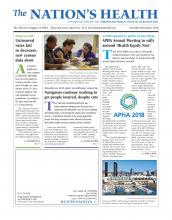As public health advocates continue to defend the Affordable Care Act from attacks in Congress and the courts, rates of health care uninsurance in the U.S. have remained stagnant, with wide disparities across populations, according to the latest data from the U.S. Census Bureau.
The “Income, Poverty and Health Insurance Coverage in the United States: 2017” report released Sept. 12 shows that 28.5 million Americans lacked insurance in 2017, compared with 28.1 million in 2016, representing a statistically insignificant difference.
“The impressive gains in insurance coverage since the implementation of the ACA have certainly flattened out in the U.S.,” Robert St. Peter, MD, president and CEO of the Kansas Health Institute, said in a news release. “How much of that is due to confusion or hesitancy related to the continued political battles around the ACA, and how much is due to other factors is hard to say.”
Meanwhile, the number of Americans with health insurance coverage increased by 2.3 million, with more than 91 percent of people insured at some point in 2017. More people were covered by private health coverage than government health coverage, at 67.2 percent and 37.7 percent, respectively. Fifty-six percent of people with health coverage had employer-based insurance, followed by 19.3 percent of people covered by Medicaid and 17.2 percent of people covered by Medicare.
While most people did have some form of health insurance from 2016 to 2017, the Census figures indicated large disparities in rates of coverage. Data from the American Community Survey, released Sept. 13, show that uninsurance rates varied greatly across states, from 2.8 percent in Massachusetts to 17.3 percent in Texas. The percentage of uninsured people decreased in three states and increased in 14 states, with a disproportionate share of uninsured people residing in the South. Overall, the rate of uninsurance was lower in states that expanded Medicaid.
Most uninsured people were working-age adults ages 19-64, accounting for nearly 85 percent of people without health insurance. More than half of uninsured people were male and were also more likely to have less than a high school education and be low-income.
Almost 94 percent of whites had health coverage, followed by about 93 percent of Asians, 89 percent of blacks and 84 percent of Hispanics.
There were also stark differences in rates of health coverage at the intersection of race and gender, as the census figures showed. The National Partnership for Women & Families analyzed the income, poverty and health insurance report, finding that women of color are more likely than their white counterparts to lack health insurance. According to the organization’s analyses, about 20 percent of Hispanic women, 14 percent of black women and 9 percent of Asian women were uninsured, compared with 8 percent of white women.
“Members of Congress can and should take action to reduce disparities and advance — not reverse — progress,” Debra Ness, president of the National Partnership for Women & Families, said in a news release. “Lawmakers must strengthen the ACA instead of undermining it.”
And for the first time since the Affordable Care Act went into effect, uninsurance rates among people ages 18-34 increased. Since the Affordable Care Act first allowed people up to age 26 to stay on their parents’ health insurance, uninsurance numbers had been falling among young adults. But from 2016 to 2017, 350,000 more people in the 18- to 34-year-old age group lacked health coverage.
“Young adults have benefited from the Affordable Care Act for years, with the uninsured rate dropping significantly every year,” Tom Allison, MPP, deputy policy and research director for Young Invincibles, said in a news release. “It’s no secret the Trump administration is dead set on dismantling a law that has helped them get the care they need at a price they can afford. Now we’re officially moving backwards, back to a time when fewer young people were protected by quality, affordable health insurance.”
For more information, visit www.census.gov.
- Copyright The Nation’s Health, American Public Health Association









